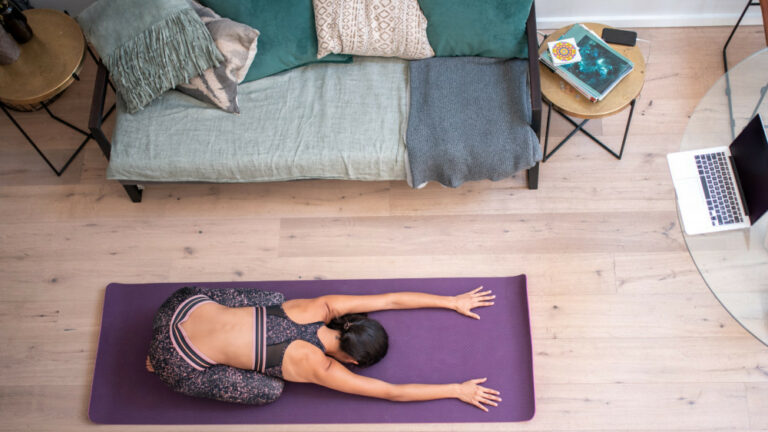The Benefits Of Vajrasana Yoga

The Benefits Of Vajrasana Yoga: Transform Your Health And Well-Being
Discover the transformative benefits of Vajrasana yoga! This simple yet effective pose offers numerous health advantages, from improving digestion to reducing stress.
Embrace Vajrasana yoga to enhance well-being and unlock a healthier, more balanced life. Dive into our blog to learn how this powerful practice can elevate your health journey.
What Is Vajrasana?
‘Vajrasana' comes from the Sanskrit words ‘Vajra,' which means thunderbolt or diamond, and ‘Asana,' which means posture.
Vajrasana yoga is known for its benefits, which impact the practitioner's physical, mental, and spiritual aspects. It is an integral part of yoga routines aimed at holistic well-being.
Vajrasana is a kneeling pose in which one sits back on one's heels with their knees, ankles, and toes touching the ground.
To perform this asana, kneel on the yoga mat, bring your knees together, and sit back on your heels so that your buttocks rest on the soles of your feet.
Position your hands on your thighs, palms facing downward. Keep your back straight and focus on your breath, maintaining this posture for several minutes.
This pose is unique because, unlike many other yoga postures, it can be practiced immediately after eating. It is particularly revered for improving digestion and stimulating metabolic processes.
Vajrasana is also known to center and calm the mind, making it an excellent posture for meditation and mindfulness.
Physical Benefits Of Vajrasana
Vajrasana, also known as the Thunderbolt Pose or Diamond Pose, is a kneeling posture in yoga that offers several physical benefits:

1. Vajrasana Improves Digestion
Vajrasana aids in improving digestion by enhancing blood flow to the stomach and intestines, facilitating more efficient nutrient absorption.
After a meal, adopting this position can help avoid common digestive problems like gas and bloating.
By stimulating the digestive organs and promoting a gentle massage of the abdominal region, Vajrasana ensures better assimilation of nutrients, leading to improved overall digestive health.
Regular practice of this pose can significantly enhance your digestive system’s functionality and relieve discomfort after eating.
2. Strengthens Pelvic Muscles
Vajrasana strengthens the pelvic muscles and ligaments, providing significant benefits for both men and women.
This pose can help alleviate menstrual discomfort by enhancing blood flow and reducing cramps for women.
Additionally, strengthening the pelvic region improves reproductive health and can be especially beneficial during pregnancy and childbirth.
By regularly practicing Vajrasana, individuals can improve the flexibility and stability of their pelvic muscles, leading to overall better pelvic health and reduced discomfort associated with menstruation and other pelvic-related issues.

3. Vajrasana Relieves Lower Back Pain
Vajrasana effectively relieves lower back pain by encouraging proper posture and spine alignment.
When done with an upright spine, this pose aids in evenly distributing weight across the body, easing the strain on the lower back.
Sitting in Vajrasana activates your core muscles and encourages a neutral spine alignment, which helps relieve tension and discomfort in the lower back.
This posture also gently stretches the lower back muscles, making it especially helpful for individuals with chronic pain.
Regular practice of Vajrasana can lead to improved spinal alignment and long-term relief from lower back pain.
4. Alleviates Knee Pain
Practicing Vajrasana can alleviate knee pain by strengthening the muscles surrounding the knee joints and improving joint flexibility.
By sitting in this pose, you engage the quadriceps and hamstring muscles, which support and stabilize the knee.
Additionally, Vajrasana helps alleviate stiffness and discomfort in the knee joints through gentle stretching and alignment promotion.
The consistent practice of this pose increases blood flow to the knees, which aids in reducing inflammation and encourages healing.
Additionally, Vajrasana can help improve balance and support proper alignment, contributing to long-term knee health and comfort.
5. Enhances Circulation
The benefits of Vajrasana Yoga include improving blood circulation throughout the body, with particular benefits for the abdominal region and lower extremities.
When you sit in this posture, the alignment of your spine and the gentle pressure on your legs helps stimulate blood flow from the lower body back toward the heart.
This increased circulation promotes cardiovascular health by ensuring oxygen-rich blood reaches all body areas more efficiently.
Enhanced circulation also supports the delivery of nutrients to tissues, helps remove metabolic waste, and can improve overall energy levels and vitality.
6. Tones The Abdomen
Vajrasana tones the abdomen by gently compressing the abdominal organs and engaging the core muscles.
When you sit in Vajrasana, the pressure exerted on the abdominal region stimulates the digestive organs and activates the core muscles.
This natural compression and activation help strengthen the abdominal muscles, leading to a firmer and more toned midsection.
Additionally, regular practice of Vajrasana can assist in reducing belly fat by improving digestion and metabolism, which supports a healthier body composition.

7. Vajrasana Boosts Metabolism
Vajrasana, a traditional yoga pose performed by sitting on your knees with your feet flat beneath you, is known for the benefits of Vajrasana Yoga on metabolism.
Vajrasana enhances digestion and boosts metabolic rate by gently applying pressure to the abdominal area and stimulating digestive organs.
This natural boost in metabolism supports effective weight management and contributes to overall energy levels.
Regular practice of Vajrasana can lead to improved digestion, a more efficient metabolism, and a greater sense of vitality, making it a valuable addition to any wellness routine.
8. Improves Posture
Maintaining a straight spine in Vajrasana improves posture and body alignment. This pose encourages proper spinal alignment and strengthens the muscles that support good posture by focusing on keeping the back upright and the shoulders relaxed.
Over time, practicing Vajrasana helps develop a natural, balanced posture, which can reduce strain on the muscles and joints.
This improved body mechanics alleviates discomfort and promotes long-term musculoskeletal health, making Vajrasana an effective practice for achieving and maintaining better posture in daily life.
9. Enhances Flexibility
Regular practice of Vajrasana offers significant benefits for enhancing flexibility in the hips, thighs, and ankles.
As you sit in this pose, the gentle stretch applied to these areas helps to gradually increase their range of motion and suppleness.
Over time, this improved flexibility reduces stiffness and discomfort while minimizing the risk of injuries during physical activities.
By consistently practicing Vajrasana, you strengthen the muscles and ligaments around the joints, which supports better movement efficiency and overall joint health.
This increased flexibility enhances physical performance and contributes to a more active, injury-resistant lifestyle.

10. Vajrasana Yoga Supports Joint Health
Vajrasana Yoga benefits by encouraging the production of synovial fluid, which is essential for keeping joints lubricated and flexible.
When you practice Vajrasana, the seated position helps to stimulate the production of this natural lubricant, which nourishes the cartilage and reduces friction between the bones.
This enhanced lubrication contributes to healthier joints, making them less prone to stiffness and discomfort.
Over time, regular practice of Vajrasana can improve joint mobility, support overall joint function, and help maintain flexibility, leading to better joint health and a more comfortable range of motion in daily activities.
11. Assists In Relaxation
Vajrasana facilitates deep relaxation by offering a secure and pleasant sitting position that eases the discharge of tension from the body.
The pose's grounded nature encourages a sense of calm, allowing you to focus on your breath and center your mind.
This gentle, restorative posture helps soothe the nervous system, reduce stress, and foster mental and physical relaxation.
Regular practice of Vajrasana can be particularly effective for winding down after a long day, facilitating a peaceful transition to rest and enhancing overall well-being.
Please click here to read about The Surprising Benefits Of Goat Yoga
or here for the article An Overview Of Yoga With Health Benefits
Mental Benefits Of Vajrasana
Incorporating Vajrasana into your daily routine can help cultivate these mental benefits, contributing to a more balanced and centred state of mind.

1. Vajrasana Reduces Stress
Practicing Vajrasana is an effective way to reduce stress and promote mental relaxation. When you settle into this pose, the gentle alignment of the body encourages a state of calm and tranquillity.
The physical stability of Vajrasana creates a foundation for mental stillness, allowing you to focus on your breath and clear your mind of daily worries.
This mindful practice activates the parasympathetic nervous system, which counteracts the stress response and fosters a sense of inner peace.
Regular practice of Vajrasana can help lower cortisol levels, reduce anxiety, and create a more serene mental state.
2. Enhances Concentration
Vajrasana significantly enhances concentration and focus by fostering mindfulness and mental clarity.
As you sit in this posture, the stable and upright position encourages you to be present and attentive to your breath, which calms the mind and reduces mental distractions.
This focused mental state helps to sharpen your concentration, making engaging in tasks requiring sustained attention easier.
Whether for academic studies, professional work, or personal projects, regular practice of Vajrasana can improve cognitive function, boost productivity, and facilitate a more effective and focused approach to your endeavours.
3. Alleviates Anxiety
Vajrasana is highly effective in alleviating symptoms of anxiety and nervousness through its calming and stabilizing effects.
By sitting in this grounded posture, you encourage a state of mental stillness that counteracts feelings of anxiety.
Sitting upright with a focus on your breath creates a sense of stability and presence, helping to clear your mind of worries and concerns.
This mindful practice lowers cortisol levels, the stress hormone, and activates the parasympathetic nervous system, promoting relaxation and a sense of calm.
Regular practice of Vajrasana can, therefore, be a valuable tool for managing anxiety and achieving a more balanced emotional state.
4. Improves Mental Clarity
Vajrasana improves mental clarity by creating a conducive environment for mindfulness and focused attention.
As you sit in this pose, the emphasis on maintaining a straight spine and concentrating on your breath helps to quiet the mind and dispel mental fog.
This meditative state lets you remove daily distractions and cultivate a clearer, more focused mental perspective.
The deep, rhythmic breathing associated with Vajrasana soothes the mind and sharpens cognitive function, enhancing mental clarity and better decision-making abilities. Regular practice promotes a more lucid and organized thought process.

5. Vajrasana Boosts Emotional Stability
Regular practice of Vajrasana significantly boosts emotional stability by promoting balance within the nervous system and fostering a sense of inner equilibrium.
This pose encourages you to sit calmly and focus on your breath, which helps to regulate the body's stress response and create a soothing environment for emotional balance.
By engaging in this practice consistently, you strengthen your ability to manage emotional fluctuations and respond to stressors with greater calmness.
The meditative aspect of Vajrasana nurtures resilience, leading to improved emotional well-being and a more stable, composed approach to life’s challenges.
6. Enhances Self-Awareness
Vajrasana enhances self-awareness by creating a space for introspection and inner reflection. The physical stillness of the pose encourages you to turn your attention inward, focusing on your breath and the present moment.
This mindful practice helps you connect more deeply with your thoughts, feelings, and emotions, providing insights into your mental and emotional state.
Regularly practicing Vajrasana can develop a greater understanding of your inner self, leading to improved self-awareness and a more conscious, mindful approach to your personal and professional life.
7. Reduces Depression Symptoms
Vajrasana can be a helpful practice for reducing symptoms of depression by fostering a sense of well-being and positivity.
The pose encourages happiness and emotional equilibrium because it triggers the release of the body's natural mood enhancers, endorphins.
Additionally, the calm and meditative nature of Vajrasana provides a break from negative thought patterns, offering mental clarity and emotional relief.
Regular practice of this pose can create a supportive environment for managing depression, resulting in improved mood and a more positive outlook on life.
8. Encourages Mindfulness
Practicing Vajrasana encourages mindfulness and present-moment awareness, essential for managing stress and improving overall mental health.
By maintaining a steady and comfortable position, you cultivate increased awareness of your breath and body.
This mindful approach helps center your thoughts and keeps you engaged in the present moment, reducing stress and anxiety.
Regular practice of Vajrasana encourages the growth of transferable mindfulness skills that benefit many facets of life, such as enhanced mental clarity, better emotional control, and a more balanced outlook on day-to-day difficulties.

9. Vajrasana Improves Sleep Quality
Vajrasana is a powerful technique for improving sleep quality and treating insomnia by lowering physical tension and soothing the mind.
The pose promotes relaxation through deep, mindful breathing and a stable sitting posture, which helps ease mental and physical stress.
This tranquillity fosters a peaceful state that supports achieving restful sleep. Additionally, practicing Vajrasana before bedtime can help unwind from the day’s stresses, setting the stage for a more restorative sleep.
Regular practice can thus enhance sleep quality, leading to better rest and improved overall well-being.
10. Promotes Mental Resilience
Regular practice of Vajrasana is key to building mental resilience and enhancing your ability to cope with life’s challenges.
The discipline of maintaining a stable, mindful posture fosters mental strength and endurance. As you practice, you develop patience, focus, and a calm demeanour, which help you manage stress and confront adversities with a positive mindset.
This consistent practice encourages a resilient attitude, enabling you to navigate difficulties more effectively and recover from setbacks more easily. Over time, Vajrasana supports the growth of a resilient and balanced mental state.
11. Enhances Memory
Vajrasana enhances memory and cognitive function by promoting improved brain health and improving blood flow to the brain.
The focused, meditative nature of the pose helps calm the mind and reduce mental clutter, which can improve cognitive processes such as memory retention and recall.
Additionally, the physical alignment in Vajrasana supports improved circulation, which benefits brain function and mental clarity.
Regular practice of this pose can lead to sharper memory, better concentration, and enhanced cognitive abilities, supporting academic and professional performance.
Spiritual Benefits Of Vajrasana
Explore how this ancient pose cultivates meditation, inner peace, energy balance, and spiritual awareness for profound personal growth and enlightenment.
1. Facilitates Meditation
Vajrasana is an excellent posture for meditation, offering a stable and comfortable base that supports prolonged periods of introspection and spiritual practice.
Sitting with a straight spine and your knees on the ground creates a solid foundation that helps maintain physical stability and mental focus.
This grounded position allows you to sit for extended sessions without discomfort, which is crucial for deep meditation.
Vajrasana is useful for improving meditation techniques and reaching a peaceful, contemplative state because its alignment promotes a calm, focused mind and a stronger connection to your spiritual nature.
2. Balances Chakras
Vajrasana significantly balances the body’s energy centers, particularly focusing on the root and sacral chakras.
This grounded position creates a stable foundation that aligns energy flow and promotes balance.
The pose helps activate and harmonize the root chakra, associated with stability and security, and the sacral chakra, linked to creativity and emotional well-being.
This balanced energy flow fosters overall energetic harmony, supporting spiritual growth and a more centred approach to life’s challenges.

3. Vajrasana Deepens Spiritual Connection
Practicing Vajrasana regularly deepens your spiritual connection by fostering a tranquil and reflective environment.
The pose encourages physical stillness and mental focus, creating a space to explore your spiritual self and connect with a higher consciousness.
By maintaining this posture, you enter a meditative state that enhances your awareness of the universe and your place.
Through this deeper spiritual connection, individuals experience enhanced personal growth and a heightened sense of unity with the world.
This enriches their spiritual practice and fosters a profound sense of purpose and inner peace.
4. Promotes Inner Peace
Vajrasana promotes inner peace by calming the mind and reducing internal chatter. The pose’s stable and supportive position helps you ground yourself in the present moment, quieting mental distractions and fostering a serene state of mind.
Focusing on your breath and maintaining physical stillness creates a peaceful mental environment conducive to relaxation and spiritual reflection.
Regular practice of Vajrasana can lead to a profound sense of inner tranquillity, helping you manage stress and cultivate a calm, balanced approach to daily life and spiritual practice.
5. Enhances Intuition
Vajrasana enhances intuition and inner wisdom by fostering a state of inner stillness and receptivity.
The pose encourages a calm and meditative state, allowing you to turn inward and listen to your inner voice.
As you maintain this posture, the physical stillness and focus on your breath help quiet the mind, making accessing deeper intuitive insights and spiritual guidance easier.
This enhanced state of receptivity supports the development of intuition, helping you connect with your inner wisdom and navigate life’s decisions with greater clarity and confidence.

6. Vajrasana Cultivates Patience
Maintaining Vajrasana requires patience and stillness, which can be cultivated through consistent practice.
The posture demands a calm and steady presence, which teaches you to embrace stillness and develop patience.
Holding the pose teaches you to stay focused and relaxed, which can translate into your daily life and spiritual practice.
This cultivation of patience helps you approach challenges with a more composed and thoughtful mindset, fostering a deeper sense of serenity and resilience in personal growth and spiritual development.
7. Supports Spiritual Growth
Vajrasana is a powerful practice supporting spiritual growth and development by creating a stable and reflective environment for inner exploration.
The pose encourages physical stillness and mental calm, which is essential for introspection and self-reflection.
Regularly practicing Vajrasana sets the stage for deeper spiritual inquiry, allowing you to connect with your higher self and explore your spiritual path.
This posture supports your journey toward enlightenment by helping you create a consistent practice of mindfulness and meditation, which fosters personal growth and a deeper understanding of your spiritual nature.
8. Aligns With Pranayama
Vajrasana aligns seamlessly with pranayama (breath control) practices, which are crucial for spiritual development and the regulation of life force energy.
In this posture, the stable and upright position supports effective breathing techniques by allowing for a steady and deep breath.
This alignment enhances the flow of prana (life force energy) throughout the body, essential for spiritual growth and energy balance.
The combined practice of Vajrasana and pranayama helps to strengthen the mind-body connection, deepen your meditation practice, and advance your spiritual development through controlled and conscious breathwork.
9. Enhances Awareness
Practicing Vajrasana enhances awareness of the body, mind, and spirit, fostering a holistic approach to personal growth and spiritual evolution.
The pose’s physical stability supports mental focus and introspection, creating an optimal environment for increased self-awareness.
Sitting in this grounded position can make you more attuned to your internal states, including thoughts, emotions, and spiritual insights.
This heightened awareness encourages a deeper understanding of yourself and your spiritual journey, promoting personal development and a more integrated approach to spiritual practice and growth.
10. Strengthens Mind-Body Connection
Vajrasana strengthens the mind-body connection, a crucial aspect of effective spiritual practices that seek harmony between the physical and subtle bodies.
The pose’s focused and stable posture helps bridge the gap between mental and physical states, encouraging a deeper integration of body awareness with spiritual mindfulness.
By maintaining this position, you cultivate a sense of unity and balance between your bodily sensations and mental processes.
This strengthened mind-body connection supports spiritual practices, enhances meditation, and fosters a more profound experience of inner peace and spiritual growth.
11. Promotes Transcendence
Vajrasana promotes transcendence by helping practitioners move beyond the limitations of the physical body and mind to access higher states of consciousness.
The pose creates a supportive foundation for meditation and spiritual practice, allowing you to transcend everyday distractions and connect with a deeper spiritual dimension.
As you maintain the stillness and focus of Vajrasana, you open yourself to experiences of higher awareness and spiritual awakening.
This transcendence facilitates the exploration of spiritual realms and the pursuit of enlightenment, helping you achieve greater insight and connection with the divine.
How To Perform Vajrasana
Vajrasana, the Thunderbolt Pose in yoga, embodies physical stability, mental clarity, and spiritual growth. Explore how this ancient posture cultivates meditation, inner peace, and energy balance.
A. Preparatory Poses
To prepare your body for Vajrasana, practicing some preparatory poses that warm up and stretch the muscles can be helpful. These poses include:
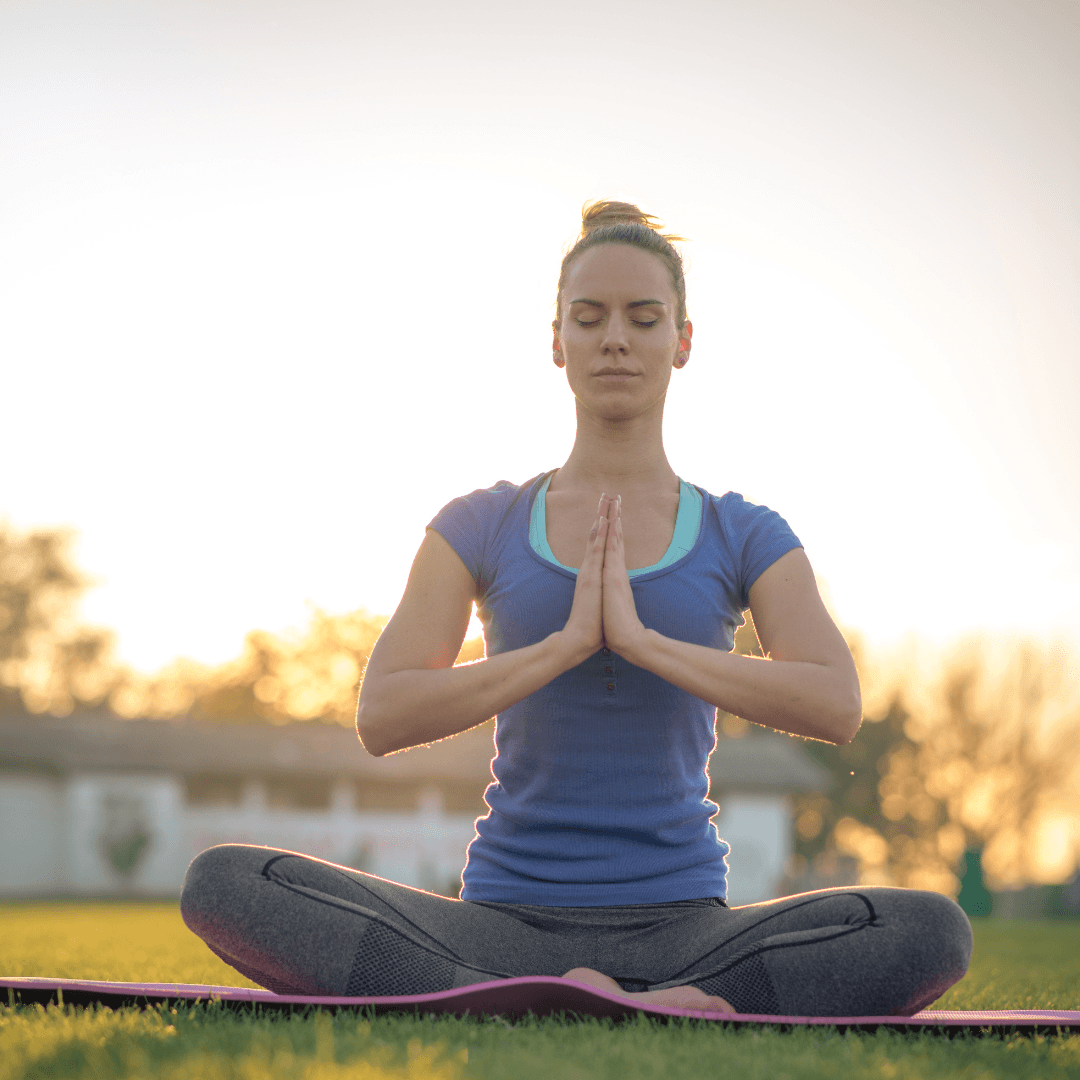
1. Sukhasana (Easy Pose)
Assume a cross-legged position with your spine erect and hands resting on your knees. This pose helps open the hips and prepare the body for a seated position.
2. Balasana (Child’s Pose)
Start by kneeling on the mat and sitting back on your heels. Extend your arms forward and lower your forehead to the ground. This position helps stretch the back and promotes relaxation.
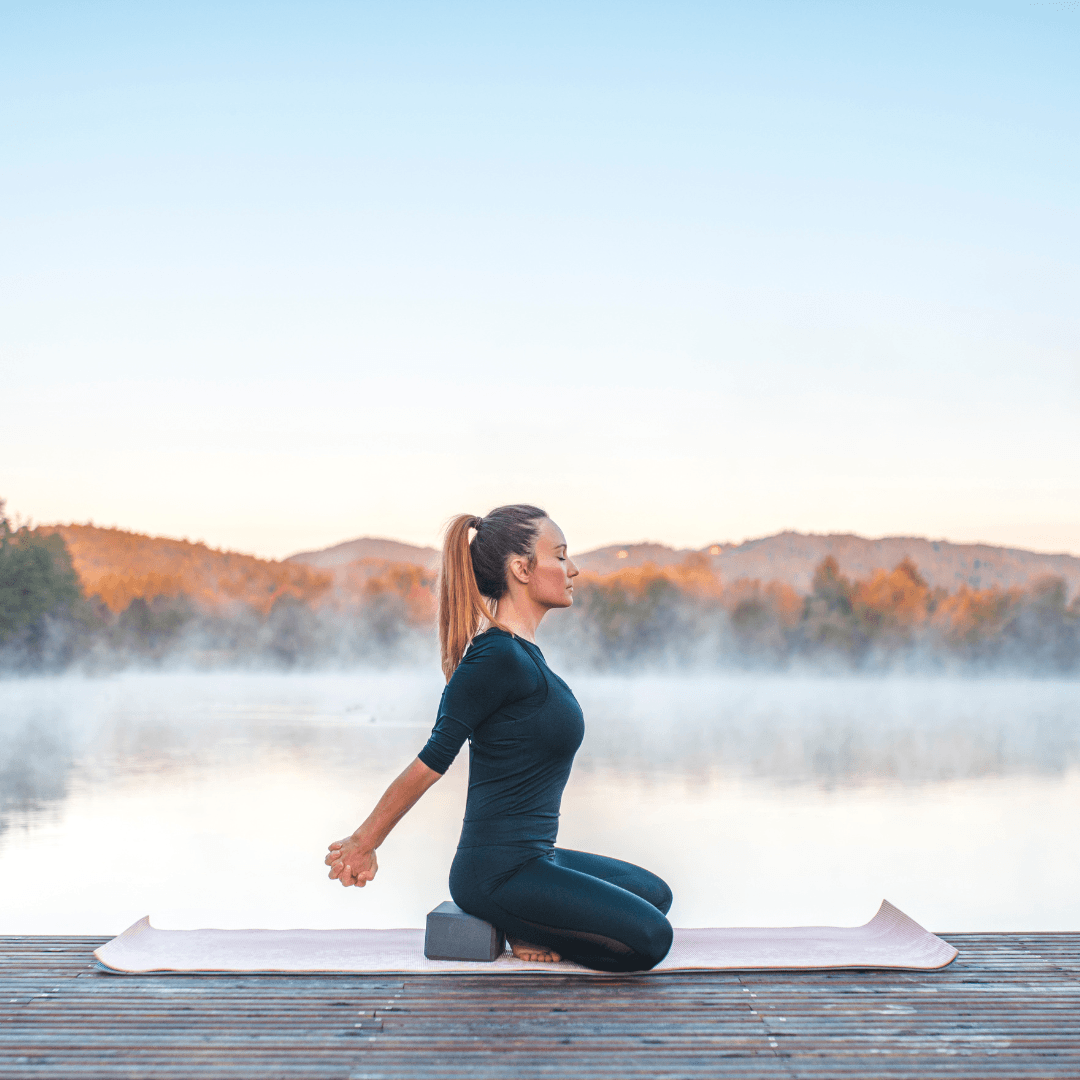
3. Virasana (Hero Pose)
Kneel on the mat with your feet together and sit back between your heels. This pose helps stretch the thighs and ankles, preparing them for Vajrasana.
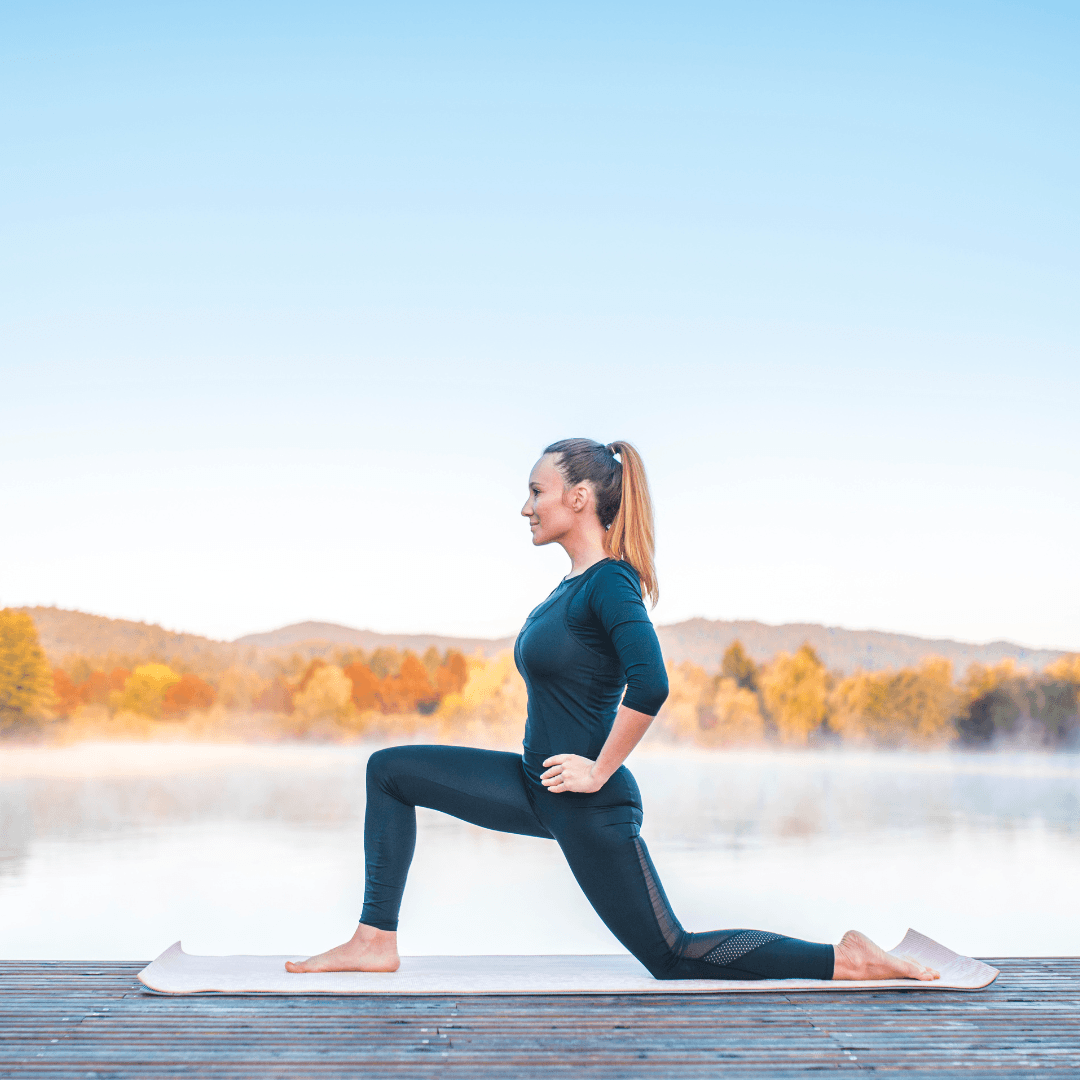
4. Anjaneyasana (Low Lunge)
Extend one foot forward into a lunge position with the back knee on the ground. This pose increases lower body flexibility and stretches the hip flexors.
Step-By-Step Guide To Performing Vajrasana
Now that your body is warmed up and prepared let's go through the steps to perform Vajrasana:
Step 1: Find A Comfortable Space
Select a peaceful and cozy area to perform Vajrasana. Place a yoga mat or other soft surface under your knees and ankles for comfort. Wear loose-fitting clothing to allow for maximum mobility.
Step 2: Kneel On The Mat
To begin, place your feet slightly apart and kneel on the mat with your knees together. Your heels should be slightly apart, and your big toes should be in contact with each other to create a “V” shape.
Step 3: Sit Back On Your Heels
Slowly lower your buttocks to sit back on your heels. Ensure that your heels are touching the sides of your hips. Ensure your heels and sit bones receive the same amount of weight.
Step 4: Align Your Spine
Maintain an upright posture with relaxed shoulders. Envision a line that runs straight from the top of your head to the base of your tailbone. Refrain from hunching over or bending over.
Step 5: Place Your Hands On Your Thighs
Position your hands on your thighs, palms facing downward. Keep your arms relaxed and your elbows close to your body. This position helps ground and stabilize your posture.
Step 6: Shut Your Eyes And Focus On Breathing
Shut your eyes and inhale deeply multiple times, paying attention to the feel of each breath coming in and out of your body. Maintain a slow and steady breathing pattern, letting your mind calm and center.
Step 7: Hold The Pose
Hold Vajrasana for as long as it is comfortable. For beginners, start with 1-2 minutes and gradually extend to 5-10 minutes or more. Pay attention to your body and avoid pushing yourself beyond comfort.
Step 8: Release The Pose
To release the pose, gently lift your buttocks off your heels and come back to a kneeling position. Stretch your legs out before you and shake them gently to release any tension.
Common Mistakes And How To Avoid Them
While Vajrasana is a relatively simple pose, it is essential to perform it correctly to avoid any discomfort or injury. Here are some common mistakes and tips to avoid them:
Mistake 1: Slouching Or Leaning Forward
Solution: Keep your spine straight and shoulders relaxed. Activate your core muscles to support an upright posture.
Mistake 2: Placing Feet Too Far Apart
Solution: Ensure that your big toes are touching and your heels are slightly apart. This alignment helps evenly distribute your weight.
Mistake 3: Sitting on the Heels Improperly
Solution: Sit back fully on your heels, ensuring that your sit bones are in contact with your heels. If needed, use a cushion or folded blanket under your buttocks for extra support.
Mistake 4: Holding Breath
Solution: Maintain a slow and steady breathing pattern throughout the pose. Direct your attention to your breath to enhance relaxation and concentration.
Precautions And Contraindications
Although most people find Vajrasana to be safe, there are a few cautions and contraindications to take into account:
1. Knee Injuries
If you have a recent or chronic knee injury, do Vajrasana only under the guidance of a certified yoga instructor.
2. Ankle Issues
Place a cushion or folded blanket under your ankles for support if your ankles are uncomfortable.
3. Pregnancy
Before performing Vajrasana and altering the pose, pregnant women should speak with their healthcare provider.
4. Severe Back Issues
Those with severe back issues should avoid Vajrasana or practice it under the guidance of a healthcare professional.
Tips For Mastering Vajrasana
To get the most out of your Vajrasana practice, consider these tips:

1. Use Props
Incorporating props such as cushions, folded blankets, or yoga blocks can offer additional support and enhance the comfort of the pose.
For example, you can place a cushion under your buttocks or ankles to reduce pressure on your joints.
2. Practice Regularly
Consistency is key to mastering Vajrasana. Incorporate regular practice into your routine, even if it's only for a few minutes each day.
Over time, your body will become more accustomed to the pose, and you will experience its benefits more profoundly.
3. Focus On Breath
Your breath is a powerful tool for relaxation and concentration. Focus on maintaining a slow and steady breath throughout the pose. This will help you stay present and deepen your practice.
4. Combine With Meditation
Vajrasana is an excellent posture for meditation. Combine your Vajrasana practice with a few minutes of meditation to enhance your mental and spiritual well-being. Focus on your breath, a mantra, or a focus point to quiet your mind.
5. Listen To Your Body
Be mindful of how your body feels while holding the pose. If you experience any discomfort or pain, adjust your position or use props for support. Always listen to your body and refrain from pushing yourself into discomfort.
6. Warm Up
Warming up your body with preparatory poses before practicing Vajrasana can help prevent strain and make the pose more comfortable. Incorporate some light stretches and motions to get your muscles and joints ready.
7. Gradually Increase Duration
As your body adjusts to the pose, start the period with a shorter Vajrasana period and progressively extend it. Aim to hold the position for at least 5-10 minutes to experience its benefits fully.
Advanced Variations Of Vajrasana
Vajrasana is more than just a simple yoga pose; it is a gateway to holistic health, encompassing physical, mental, and spiritual benefits.
Once you are comfortable with the basic Vajrasana pose, you can explore some advanced variations to deepen your practice:

1. Supta Vajrasana (Reclined Thunderbolt Pose)
Lean back and rest your elbows on the mat while in Vajrasana. Maintaining your knees together, slowly drop your back onto the mat.
Place your arms beside your body and place your head on the carpet. The thighs and hips are stretched more deeply with this version.
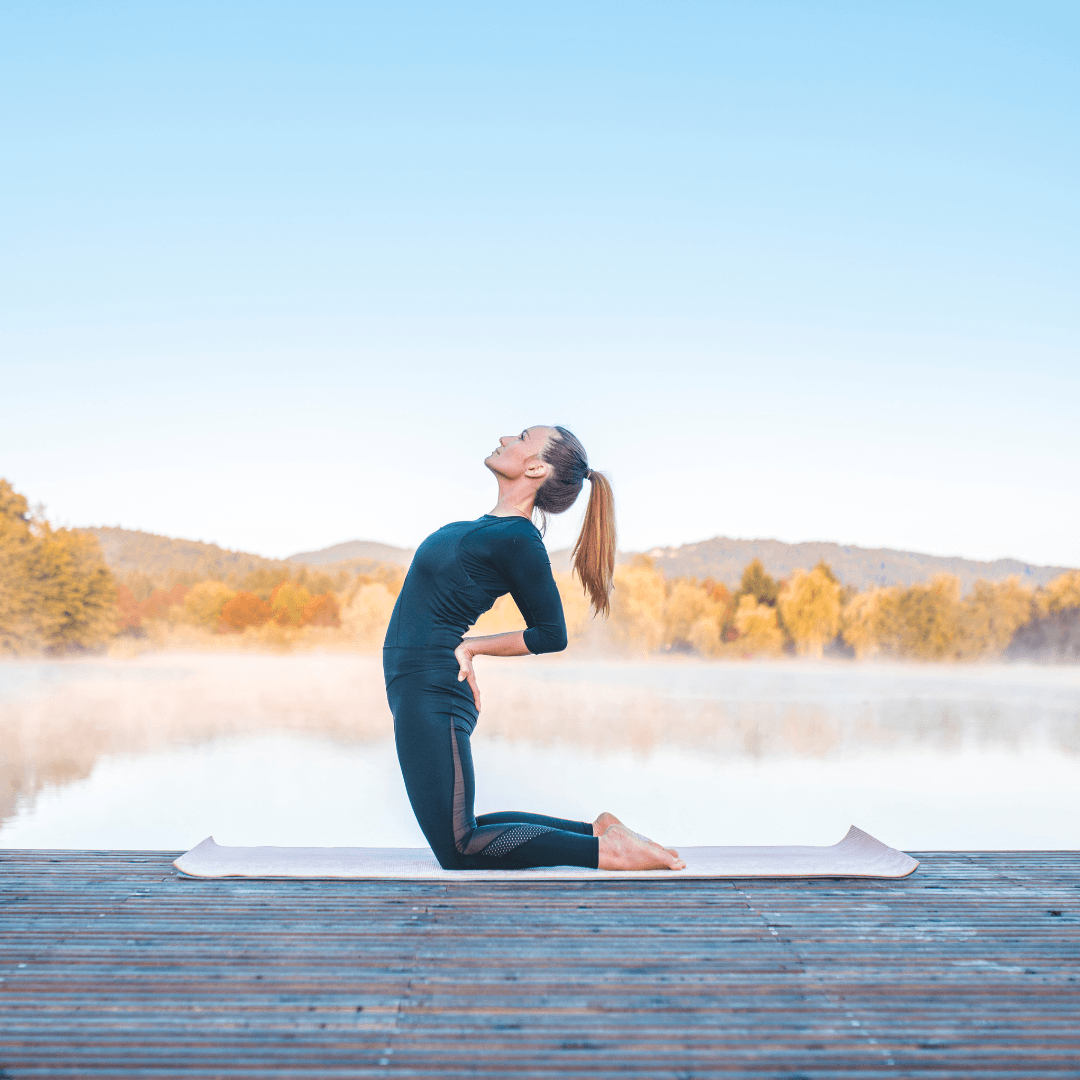
2. Ustrasana (Camel Pose)
From Vajrasana, come up to a kneeling position with your knees hip-width apart. Place your hands on your lower back for support, and gently arch your back, reaching for your heels. This variation opens the chest and stretches the front of the body.

3. Baddha Konasana (Bound Angle Pose)
Step down from Vajrasana into a sitting position with your legs in front of you. Bring the soles of your feet together and bend your knees so that they fall outward.
Grasp your feet with your hands and gently guide your knees towards the ground. This variation helps to open the hips and groin area.
FAQ
1. How Can Vajrasana Improve Digestion?
Answer: Sitting in Vajrasana after meals helps enhance blood circulation to the digestive organs, promoting better digestion and nutrient absorption.
It can also relieve bloating and discomfort. Regular practice of Vajrasana can lead to improved digestion, enhanced mental clarity, emotional stability, and a deeper spiritual connection.
2. What Should I Do If I Experience Discomfort While Practicing Vajrasana?
Answer: If uncomfortable, place a folded blanket or cushion between your thighs and calves. Ensure your back remains straight, and avoid slouching. If the pain persists, consult a yoga instructor for guidance and modifications.
3. Can Vajrasana Be Practiced During Pregnancy?
Answer: If a woman is expecting, she should speak with her doctor before performing Vajrasana. While it is generally safe, modifications may be needed to accommodate the changing body and ensure comfort and safety.
4. Can Vajrasana Help With Back Pain?
Answer: Vajrasana helps improve posture and strengthens the lower back, alleviating back pain. Keeping your back straight while practicing the pose is important to avoid strain.
Whether new to yoga or a seasoned practitioner, incorporating Vajrasana into your daily routine can significantly contribute to your overall well-being and personal growth.
5. How Long Should I Hold The Vajrasana Pose?
Answer: Beginners can start by holding Vajrasana for 1-2 minutes and gradually increase the duration to 5-10 minutes. With regular practice, you can have the pose for longer periods.
6. When Is The Best Time To Practice Vajrasana?
Answer: Vajrasana can be practiced at any time of the day. It is one of the few yoga poses that can be performed immediately after eating, making it ideal for aiding digestion.
However, it is best practiced on an empty stomach or a few hours after a meal for maximum benefits.
Conclusion
In conclusion, incorporating Vajrasana into your yoga practice can profoundly transform your health and well-being.
By fostering physical stability, enhancing mental clarity, and promoting spiritual growth, this ancient posture offers a holistic approach to achieving balance in life.
Vajrasana is a fundamental tool for fostering a healthier and more harmonious living, regardless of your goals—to increase flexibility, lower stress, or intensify your spiritual practice.
Embrace the benefits of Vajrasana and embark on a journey towards greater vitality, peace, and inner strength.
I trust you enjoyed this article, The Benefits Of Vajrasana Yoga. Please stay tuned for more blog posts soon. Take care!
JeannetteZ
>>>Please click here to read my all-inclusive article about A Comprehensive Guide To Healing Naturally<<<
>>>Are you interested in Natural Healing through Herbs? Please click here for my #1 Recommendation<<<
Your Opinion Is Important To Me
Do you have thoughts, ideas, or questions? I would love to hear from you. Please leave me your questions, experiences, and remarks about this article, The Benefits Of Vajrasana Yoga, in the comments section below. You can also email me at Jeannette@Close-To-Nature.org.
Disclosure
This post may contain affiliate links. As an Amazon Associate and other affiliate programs, I earn from qualifying purchases at no extra cost to you. Please read my full affiliate disclosure.
You might also enjoy these blog posts:
The Surprising Benefits Of Goat Yoga
Interesting Facts About Cardinals
All About Lilies: Your Ultimate Guide!
Best Types Of Lily Plants For Your Garden


